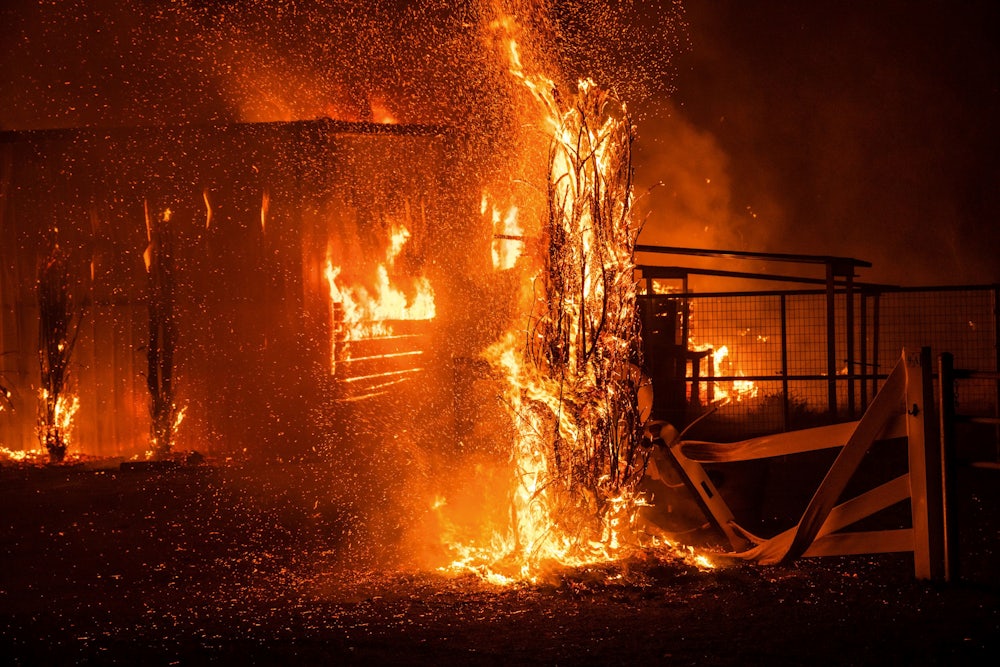In late October 2019, the Kincade Fire spread from the area near a power plant in northern Sonoma County, California, to the towns of Windsor and Healdsburg and to the northeast part of Santa Rosa. It burned 77,758 acres of land and destroyed 374 buildings. The fire prompted the largest mass evacuation—200,000 people—in county history.
KerryAnn Laufer, a textile and pottery artist, got the alert to evacuate around 10:30 a.m. “I remember thinking, ‘Oh, I’ve got five-and-a-half hours,’” she said. She made some tough choices: two suitcases; some documents; her two 40-year-old Amazon parrots; and her 14-year-old cat. “I wish now that I took some pictures, too.”
As she left her house in Healdsburg to drive 15 miles to a friend’s house in Santa Rosa, the fires were still about 20 miles away, and the winds hadn’t picked up yet. The sky was bright blue and clear, and there was no fire or smoke in sight. Laufer dropped her parrots and her cat at a veterinary hospital on the way.
Laufer felt relatively calm on her drive. After all, this was her third wildfire evacuation.
“It looked like a beautiful day, and everybody was leaving in such a calm and orderly way,“ Laufer said. “The emergency personnel were so ahead of everything. Everybody was prepared to follow the fire precautions. Our community experienced the Tubbs Fire only two years ago.”
Six days later, with the fire fully tamed, Laufer didn’t know what had happened to her house. She tried to visit—some days even twice—but National Guard troops cut her off a mile from her house. Meanwhile, news reports said over 300 structures had been lost.
“I was really worried, but I had lots of respect for the guards. They were keeping us safe,” Laufer said. “[That] Thursday, I came by a second time. A National Guardsman recognized me and felt sorry for me. He instructed two sheriffs to escort me to my house, and finally I was able to find out what happened.”
As Laufer drove up with the sheriffs by her side, she saw that her house was gone. All that was left was her fireplace.
“The fire had jumped, so some houses on my street burned and some didn’t,” Laufer says. “A couple of duplexes across the road suffered severe smoke damage, but the house across from me did burn. My shed was saved, so were all my oak trees, but everything else was gone—all my artwork and all the tools burned in the garage, which I had turned into an art studio.”
Now, Laufer stays in a temporary apartment about 10 miles from the property which had held 19 years’ worth of memories and her life’s work.
“I found a landlady who wanted to help somebody who had been affected by the fire,” Laufer said. She appreciated the waived application. “I am very privileged and fortunate to have good insurance and that helps a lot. I wish I had just taken more artwork with me. The only thing I have now is a quilt that I made for my mother who has since passed.”
The threat from wildfires can last long after they’re put out. Damage to vegetation can leave the area prone to flooding and mudslides. So the rainy season brought Laufer further worries about her property.
“I have lots of anxiety right now,” she said. “I feel like I haven’t even had time to wrap my head around what happened, and I’m concerned that, if it rains, my property will get worse before it gets better. I had a wooden wall around my property, and it burned. Today, I thought to sew new curtains for my apartment, but then I realized I don’t have my sewing machine. Neither do I have fabric. Oh, I had beautiful fabrics in my studio.”
Laufer said that when she starts to feel overwhelmed with regret for the things she lost, like her valuable antique European pottery collection or her jewelry, she tries to shift her mindset.
“I’m 62-years-old and I reconcile my own participation in this consumer culture that we all are in,” she said. “In the past, I was also a victim of burglaries, so over the years I’ve worked on spiritually not being so attached to my things. I seem to have a better reaction to losing my things than a lot of other fire survivors. What I am really grieving is being able to go home and be in my space. I’m not really grieving my stuff. I also suffer from too much information. It is a lot to deal with emotionally: insurance, taxes, replacing documents.”
Laufer doesn’t know whether she will stay in the area and rebuild or move away. “I am in this in-between situation,” she said. “Something has definitely shifted in me, the way I look at things. I became vegan five years ago, especially to make a personal impact on the planet by changing my consumer habits. I’ve marched and become an advocate, but being vegan doesn’t save my ass when fires come through. I need to really look at where I am in my life and look at the situation California is in and the world is in. And I cannot look at it just as my problem. I am one of the people affected by it, but it is not just my problem. We need more immediate action and to stop kidding ourselves that everything is good. Because it isn’t.
“We all are on the leading edge of becoming climate refugees. I wish I knew what to do, but I don’t because I am still traumatized by all the changes in my life.”

Voices From the Future is a series from the frontlines of climate change and extreme weather in collaboration with the Julie Ann Wrigley Global Futures Laboratory at Arizona State University.
